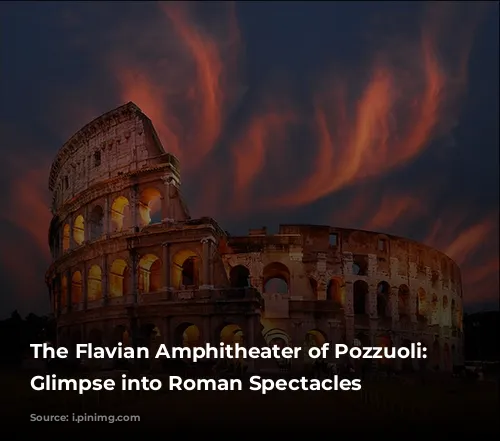Welcome to the Flavian Amphitheater of Pozzuoli, a majestic monument whispering tales of gladiatorial combats and roaring crowds! Nestled in the captivating city of Pozzuoli, this remarkable structure is the third-largest Roman amphitheater in Italy, surpassed only by the iconic Colosseum in Rome and the Amphitheater of Capua.
A Legacy of Emperors and Entertainment
The Flavian Amphitheater’s construction began during the reign of Emperor Vespasian and was likely completed under the guidance of his son, Titus. These emperors, known for their architectural prowess, may have employed the same architects who built the Colosseum, making this amphitheater a testament to their vision and skill.
Imagine the sheer scale! This elliptical structure spans an impressive 149 meters by 116 meters, with an arena measuring 72.22 meters by 42.33 meters. This vast space could accommodate a staggering 50,000 spectators, showcasing the grandeur of Roman entertainment.
Echoes of History and Martyrdom
Step into the amphitheater, and you’ll be transported back in time. While much of the interior remains intact, you can still marvel at the remnants of gears once used to lift cages into the arena, bringing the thrilling spectacle of gladiatorial combat to life.
The amphitheater played a poignant role in history. In 305 AD, it witnessed the persecution of Saint Proculus, the patron saint of Pozzuoli, and Saint Januarius, the patron saint of Naples. They were thrown to the wild beasts within its walls before being beheaded at the nearby Solfatara volcano.
A City’s History in Stone
The Flavian Amphitheater is the second of two such structures built in Pozzuoli. Sadly, the older, smaller amphitheater, known as the “Anfiteatro minore,” was largely destroyed during the construction of the Rome-Naples railway line. Only a handful of arches remain as a reminder of its presence.
The amphitheater’s location was strategically chosen, sitting at the intersection of roads leading to Naples, Capua, and Cumae. This crossroads ensured easy access for spectators from various parts of the Roman world.
Over time, the amphitheater’s fate was intertwined with the volcanic forces of the Solfatara. The volcano’s eruptions partially buried the structure, eventually leading to its abandonment. The exterior marble was stripped away during the Middle Ages, but the interior remained untouched, a silent testament to the past.
Architectural Splendor and Intricate Design
The Flavian Amphitheater boasts an architecture that echoes the grandeur of Roman engineering. Its above-ground structures share similarities with the Amphitheater of Verona, built around the middle of the first century, both displaying a polycentric curve.
However, the amphitheater’s elaborate subterranean vaults bear a strong resemblance to those found in the Colosseum, showcasing the architectural legacy of the Flavian dynasty.
Unveiling the Secrets of Roman Entertainment
The amphitheater was originally enclosed by a two-storied portico supported by trachyte pillars. These pillars were later reinforced with brick, creating a more robust structure. The portico’s exterior featured Tuscan half-columns and marble prothyra, adding an elegant touch.
The monument’s façade was a spectacle in itself, arranged in three stories. The first two stories showcased arcades, while the third featured a gallery with windows, statues, and columns, providing a grand view for those sitting in the upper tiers.
The amphitheater’s extensive network of underground chambers served a crucial role in facilitating the spectacles. Two steep ramps allowed horse-drawn carts to transport equipment and props into the arena. Wooden boards covered these corridors during performances, allowing spectators to move freely.
The amphitheater was not just a venue for entertainment; it was also a hub of social interaction. Some radial rooms may have served as “scholae,” spaces used by associations and collegia, offering opportunities for gatherings and celebrations.
A Journey Through Time: A Personal Experience
During my visit to the Flavian Amphitheater in August 2022, I was captivated by its grandeur and the whispers of its past. Sadly, the amphitheater itself was closed due to ongoing excavations and safety concerns. I longed to see the full extent of this magnificent structure. However, the exterior and the subterranean areas provided a glimpse into the history of this awe-inspiring place.
Though I couldn’t explore the arena, the experience left a lasting impression on me. The Flavian Amphitheater is more than just a monument; it’s a window into a bygone era, a testament to Roman engineering, and a symbol of the enduring legacy of this ancient civilization.
